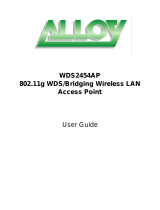
2
Table of Contents
1. Before You Start ............................................................................................................................. 3
1.1 Preface ........................................................................................................................................................... 3
1.2 Document Conventions .............................................................................................................................. 3
1.3 Package Content .......................................................................................................................................... 3
2. System Overview and Getting Started ................................................................................... 4
2.1 Introduction of LevelOne EAP-300 .......................................................................................................... 4
2.2 Deployment Topology ................................................................................................................................ 5
2.3 Hardware Description ................................................................................................................................ 6
2.4 Hardware Installation ................................................................................................................................ 8
2.5 Console Interface ........................................................................................................................................ 9
2.5 Access Web Management Interface ....................................................................................................... 11
3. Connect your AP to your Network ........................................................................................ 15
4. Adding Virtual Access Points .................................................................................................. 21
5. Secure Your AP ............................................................................................................................. 23
6. Create a WDS Bridge between two APs .............................................................................. 32
7. Web Management Interface Configuration ...................................................................... 34
7.1 System ......................................................................................................................................................... 36
7.1.1 General ............................................................................................................................................................ 36
7.1.2 Network Interface .......................................................................................................................................... 38
7.1.3 Management................................................................................................................................................... 39
7.1.4 GRE Tunnel .................................................................................................................................................... 41
7.2 Wireless ...................................................................................................................................................... 42
7.2.1 VAP Overview ................................................................................................................................................ 42
7.2.2 General ........................................................................................................................................................... 45
7.2.3 VAP Configuration ........................................................................................................................................ 47
7.2.4 Security ........................................................................................................................................................... 48
7.2.5 Repeater ......................................................................................................................................................... 51
7.2.5 Advanced ........................................................................................................................................................ 54
7.2.6 Access Control ............................................................................................................................................... 56
7.2.7 Site Survey ...................................................................................................................................................... 60
7.3 Firewall ....................................................................................................................................................... 62
7.3.1 Firewall List .................................................................................................................................................... 62
7.3.2 Service ............................................................................................................................................................ 66
7.3.3 Advanced ........................................................................................................................................................ 67
7.3 Utilities ....................................................................................................................................................... 68
7.3.1 Change Password ........................................................................................................................................... 68
7.3.2 Backup & Restore .......................................................................................................................................... 69
7.3.3 System Upgrade ............................................................................................................................................ 70
7.3.4 Reboot............................................................................................................................................................. 71
7.4 Status .......................................................................................................................................................... 72
7.4.1 Overview ......................................................................................................................................................... 72
7.4.2 Associated Client ........................................................................................................................................... 75
7.4.3 Repeater ......................................................................................................................................................... 76
7.4.4 Event Log ....................................................................................................................................................... 77
7.6 Online Help ................................................................................................................................................ 78
About 4ipnet
The LevelOne Secure WLAN Controller series is powered by 4ipnet. LevelOne is partnered with 4ipnet to deliver most feature-rich product yet
simple deployment in wireless networking infrastructure solution.
4ipnet is a leading provider of wireless networking solution for manageable, reliable, and secure wireless access. In an effort to meet changing
market demands at the least possible cost, 4ipnet delivers a diverse array of turnkey, high-performance products and mission-critical applications
to bring reliability and manageability to increasingly complex wireless networks.
4ipnet’s complete WLAN infrastructure solution portfolio addresses the needs of different network operation environments ranging from the ISP to
the SOHO, with an emphasis on simplified network deployment, centralized network management, and enhanced network performance.




















